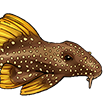How to use peat
- drpleco
- Posts: 709
- Joined: 23 Jun 2005, 03:01
- My images: 2
- My cats species list: 43 (i:0, k:0)
- Spotted: 1
- Location 2: Wausau, WI
- Contact:
How to use peat
I have seen peat used in filters to lower the Ph and soften the water. Does anyone know exactly how this is done? Do I just get some peat from the garden center, put it in a mesh bag and drop it in the filter? It has to be more difficult than this, right?
I'll be getting some wild bristlenose soon (instead of breeding commons) and may need to give them more natural water. Staining the water a bit won't be a big deal, unless I'm not able to see in at all. Thanks in advance!!!
Andy
I'll be getting some wild bristlenose soon (instead of breeding commons) and may need to give them more natural water. Staining the water a bit won't be a big deal, unless I'm not able to see in at all. Thanks in advance!!!
Andy
I've used peat for decades to soften, acidify and darken as I keep mostly tetras and other soft water fishes, and I've found most plants grow better this way. I use commercibly available peat granules designed for aquarium, in mesh bags in canister filters.
I would avise against using peat from a garden center as the peat is often modified with additional subtances for terrestial plant use.
Dave
I would avise against using peat from a garden center as the peat is often modified with additional subtances for terrestial plant use.
Dave
I dream of L-Numbers . . .
- Barbie
- Expert
- Posts: 2964
- Joined: 03 Jan 2003, 23:48
- I've donated: $360.00!
- My articles: 1
- My images: 15
- My catfish: 2
- My cats species list: 58 (i:2, k:0)
- Spotted: 8
- Location 1: Spokane, WA
- Location 2: USA
Peat is going to release tannic acid. That acid will work to soften your water, and allow your pH to fall. How far it goes, depends on how much buffering capacity the water had to start out, and just how much peat you use. My tap water here has a pH of 7.6-7.8 but is relatively soft. It can vary greatly. Without an accurate kH reading, we won't be able to give you an answer that will actually help much. Sorry!
Barbie
Barbie
- drpleco
- Posts: 709
- Joined: 23 Jun 2005, 03:01
- My images: 2
- My cats species list: 43 (i:0, k:0)
- Spotted: 1
- Location 2: Wausau, WI
- Contact:
I figured as much, but thanks anyway! I only have the "freshwater master test kit" since I'm new to catfish and have been keeping goldfish, which aren't fussy.Peat is going to release tannic acid. That acid will work to soften your water, and allow your pH to fall. How far it goes, depends on how much buffering capacity the water had to start out, and just how much peat you use. My tap water here has a pH of 7.6-7.8 but is relatively soft. It can vary greatly. Without an accurate kH reading, we won't be able to give you an answer that will actually help much. Sorry!
I may go buy a kit and some peat and see what happens. There aren't any fish in the tank yet (50gallons) so I can experiment without harming anyone.
Thanks!!
- Barbie
- Expert
- Posts: 2964
- Joined: 03 Jan 2003, 23:48
- I've donated: $360.00!
- My articles: 1
- My images: 15
- My catfish: 2
- My cats species list: 58 (i:2, k:0)
- Spotted: 8
- Location 1: Spokane, WA
- Location 2: USA
The spectrum of pH test`s depents on which Indicator they use, it is posible to make a bigger spectrum like Ph1-14 by using more indicator`s, but that way it will be not as exact as with only one or two. And if your spectrum doesn`t fit go to a chem. trader they shell such with a other spectrum like pH 4,8-5,5 (this one I use at work not in the tank of course).
A hardness test isn`t include because the chem. factory`s which make test`s, because they have allready many different test for different think`s to do with that it will raise the price if they put two different spectrum`s together. (more chance less pieces/chance
less pieces/chance  higher price
higher price  )
)
A hardness test isn`t include because the chem. factory`s which make test`s, because they have allready many different test for different think`s to do with that it will raise the price if they put two different spectrum`s together. (more chance
It's been a while since I've experimented with peat, and I can't even remember if I ever used the treated water in tanks with fish. I think I may have just been playing around for my own curiosity, so take this with a grain of salt.
I used a big bale of peat found at home depot. It should say whether or not it's been treated with anything. If I remember correctly, not all peat is alike; it has its own chemical makeup (i.e. pH) depending on where it came from, etc. This will have an influence on how much it alters your water. Other factors are: the chemical makeup of your own water and how much peat you use. If you're starting with rock hard water, using peat alone probably won't be worthwhile. But, if you're starting with pretty decent water, the use of peat can be pretty effective.
As I recall, I primarily experimented with treating the water outside of the tank because I didn't want the peat to make a mess of the tank. So, I ended up putting the peat in a coffee filter or something similiar, and straining the water into another container. For some reason, I think using hot/boiling water made the biggest impact on the tap water, but I can't really remember. This was a few years ago and I, of course, didn't write anything down. For what it's worth, my starting water is pretty soft to begin with.
I think you'd be best served looking into some probes. They're a lot more accurate, and precision is (in my opinion) crucial when working with extreme water parameters. The test strips are a pain to read, and I'm not sure how accurate they are even if you factor out user error from not picking up the subtle color differences.
Best thing I could advise would be to play around: experiment with different quantities (and types) of peat; alter the starting temperature of the water, etc and see what gets the best results.
Steve
I used a big bale of peat found at home depot. It should say whether or not it's been treated with anything. If I remember correctly, not all peat is alike; it has its own chemical makeup (i.e. pH) depending on where it came from, etc. This will have an influence on how much it alters your water. Other factors are: the chemical makeup of your own water and how much peat you use. If you're starting with rock hard water, using peat alone probably won't be worthwhile. But, if you're starting with pretty decent water, the use of peat can be pretty effective.
As I recall, I primarily experimented with treating the water outside of the tank because I didn't want the peat to make a mess of the tank. So, I ended up putting the peat in a coffee filter or something similiar, and straining the water into another container. For some reason, I think using hot/boiling water made the biggest impact on the tap water, but I can't really remember. This was a few years ago and I, of course, didn't write anything down. For what it's worth, my starting water is pretty soft to begin with.
I think you'd be best served looking into some probes. They're a lot more accurate, and precision is (in my opinion) crucial when working with extreme water parameters. The test strips are a pain to read, and I'm not sure how accurate they are even if you factor out user error from not picking up the subtle color differences.
Best thing I could advise would be to play around: experiment with different quantities (and types) of peat; alter the starting temperature of the water, etc and see what gets the best results.
Steve




